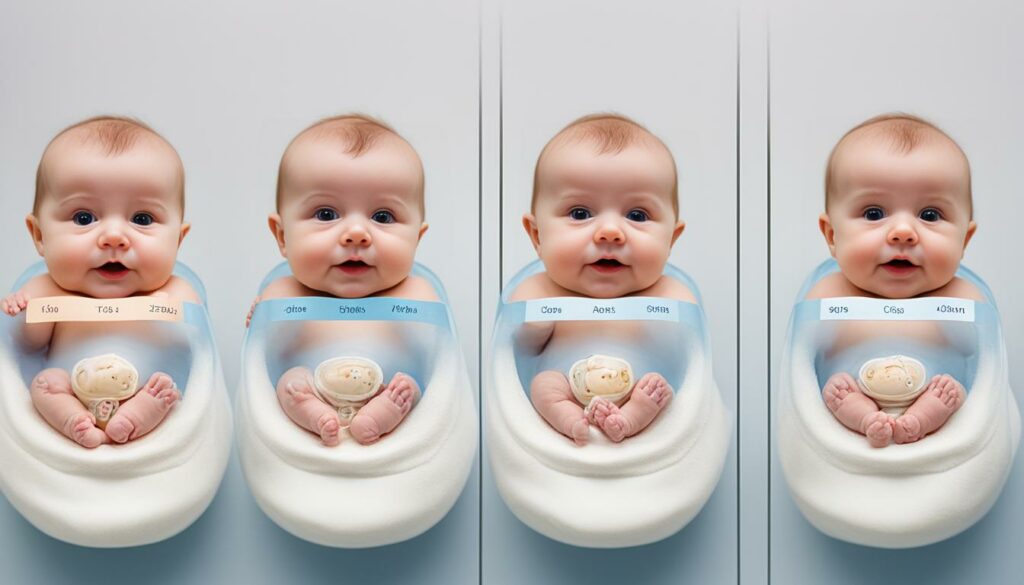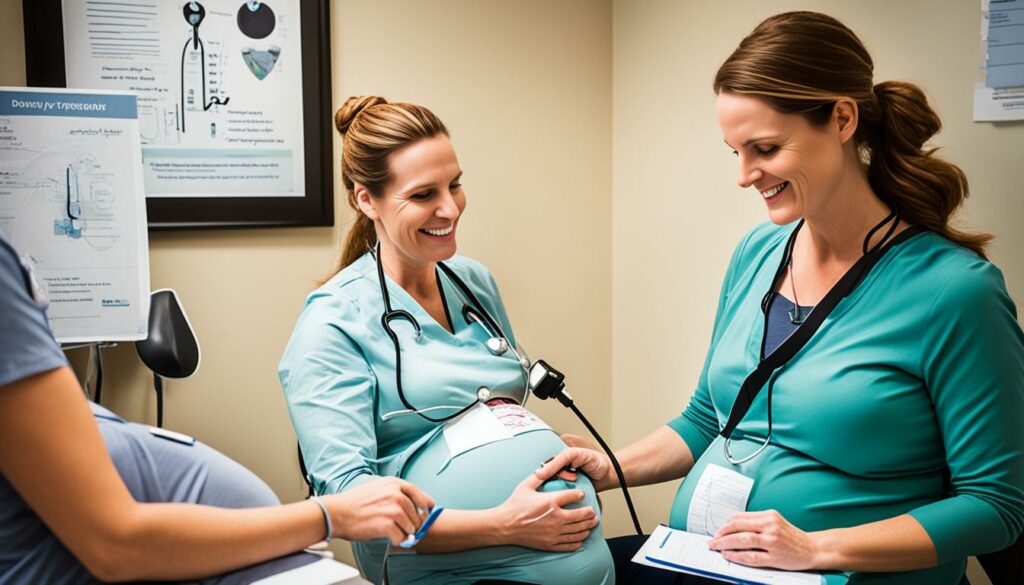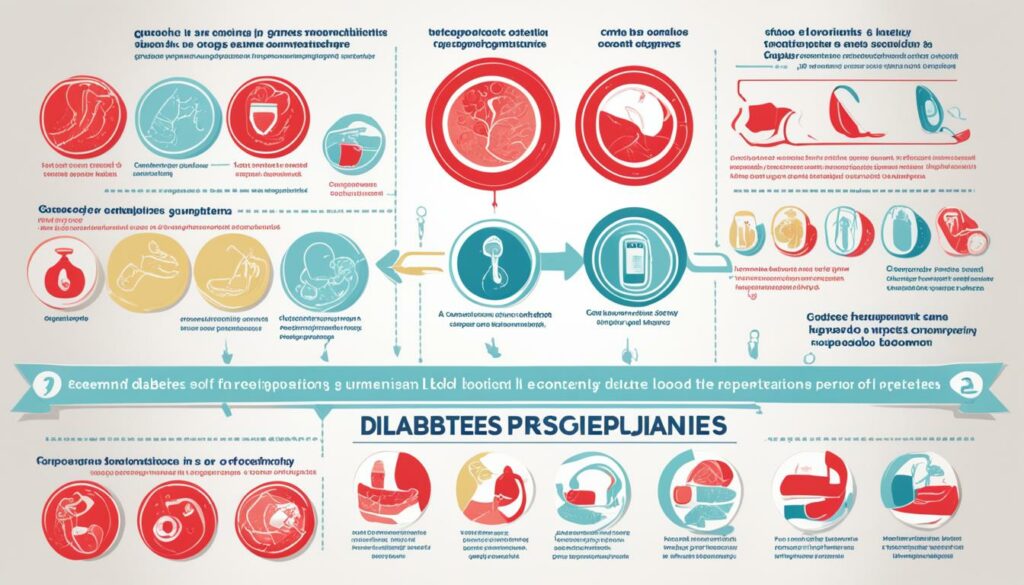Did you know that your baby experiences rapid growth during the second trimester? At the beginning, your baby measures around 10 cm (4 in) in length and weighs approximately 28 g (1 oz)1. By the end of this trimester, your baby is expected to grow to about 35 cm (14 in) in length and weigh between 1 to 2 kg (2 to 4 lbs)1. This period is crucial in your journey to motherhood.
Trimester 2 often brings fewer symptoms than the first. You might see less nausea and fatigue. This makes it a good time to take care of yourself2. Yet, stay alert to symptoms like carpal tunnel syndrome, skin darkening, back and pelvic pain, and stretch marks1. Managing these can make your pregnancy smoother.
Self-care is vital for a healthy pregnancy now. Include regular exercise, physiotherapy, wearing support belts, getting enough rest, using ice, keeping elevated, and eating well1. These steps boost both your health and your baby’s development.
If you face severe issues like cramping, fever over 38°C (100°F), bleeding, extreme swelling, or ongoing headaches, get medical help immediately1.
Key Takeaways:
- Trimester 2 is key for your baby’s growth and development1.
- Common symptoms can include carpal tunnel syndrome, skin darkening, back and pelvic pain, and stretch marks1.
- Self-care like exercise, physiotherapy, and proper nutrition supports a healthy pregnancy during Trimester 21.
- Seek medical help for severe symptoms during Trimester 21.
How You’re Feeling in Trimester 2
Trimester 2 brings a wave of relief for many expecting mothers. Nausea and fatigue tend to ease, giving you a chance to really enjoy being pregnant.
Your belly will start to grow, showing the world the new life inside you. Embrace and celebrate these changes with joy and excitement. It’s a special time to feel connected to the baby you’re carrying.
Feeling your baby move is another highlight of Trimester 2. By 20 to 22 weeks, you might feel gentle flutters. These movements create a precious bond between you and your baby. It’s a magical experience that brings happiness and love.
Symptoms like melasma and linea nigra may appear due to hormonal changes2. Stretch marks are also common, telling the story of your body’s remarkable journey2. These changes are natural and there are ways to help manage them.
Less frequent headaches and an increased appetite might occur too3. You could also experience body aches and swelling. These are all part of your body accommodating the growing life inside you4.
It’s essential to look after yourself during this time. Rest, take care of your emotional health, and enjoy light exercise3. If you face serious issues like severe cramping or difficulty breathing, contact your healthcare provider right away4. They will help ensure both you and your baby are healthy.
Common Symptoms in Trimester 2
| Symptoms | Prevalence |
|---|---|
| Melasma (brown patches on the face) | Approximately 50-75% of pregnant women |
| Linea nigra (dark lines on the abdomen) | Common in many pregnant women |
| Stretch marks | Affecting around 50-90% of pregnant women |
| Occasional headaches | Normal but typically less frequent |
| Increased appetite and body aches | Experienced by many pregnant women |
| Swelling in hands, feet, and ankles | Common during Trimester 2 |
Common Symptoms in Trimester 2
Pregnancy brings unique experiences for everyone, yet some symptoms in Trimester 2 are quite common. Knowing and handling these symptoms can make your pregnancy smoother.
Carpal tunnel syndrome often appears during this time. It causes numbness and tingling in your hands and fingers. It happens because your body retains more fluid and swells3.
Skin darkening, or melasma, is another widespread symptom. It affects 50% to 70% of pregnant women. They notice dark spots on their face2.
Pain in the lower back and pelvic area is usual too. The growing baby and hormonal shifts cause this discomfort. Stretch marks are also common, affecting 50% to 90% of pregnant women2.
Leg cramps can catch you off guard, causing sharp pains in your calves. About 30% to 50% of pregnant women experience this, especially at night2.
Many notice an increase in vaginal discharge during this period. It’s typically clear or white and sticky. This change is both common and normal2.
Urinary tract infections (UTIs) are also frequent during pregnancy. They can impact many pregnant women. UTIs need medical help to avoid any further problems2.
Even though there might be some discomforts, staying healthy and getting regular prenatal care matter most. Second-trimester check-ups help monitor the baby’s growth and the mother’s health. They check your weight and blood pressure2.
In Summary:
Trimester 2 can bring carpal tunnel syndrome, skin darkening, back and pelvic pain, stretch marks, leg cramps, more vaginal discharge, and UTIs. Understanding and managing these can lead to a more enjoyable pregnancy.
| Symptom | Prevalence |
|---|---|
| Carpal Tunnel Syndrome | Experienced by many |
| Darkening of the Skin (Melasma) | Affects approximately 50% to 70% of pregnant women |
| Lower Back and Pelvic Pain | Common discomfort |
| Stretch Marks | Affect around 50% to 90% of pregnant individuals |
| Leg Cramps | Occur in roughly 30% to 50% of pregnant women |
| Vaginal Discharge | Common and normal |
| Urinary Tract Infections | Prevalent and require attention |

Self-Care During Trimester 2
Taking care of yourself in Trimester 2 is key. You might see symptoms improve, yet face new body changes. It’s crucial to look after yourself and ease any discomforts. Here are tips for a healthy second trimester:
1. Managing Lower Back and Pelic Pain
Many women feel back and pelvic pain during this time1. Good posture, using pillows for support, and back-strengthening exercises can help. Always check with your health-care provider before starting new exercises.
2. Coping with Carpal Tunnel Syndrome
Carpal tunnel syndrome might cause numb hands and fingers in pregnancy. To help, try wrist splints, do hand exercises, and take breaks from hand movements. Your health-care provider can offer more advice1.
3. Treating Stretch Marks
Stretch marks are common, but you can lessen them. Keep your skin moisturized, eat well, and drink plenty of water. Talk to your health-care provider for more options1.
4. Embracing Exercise
Exercise helps maintain strength, stamina, and mood during pregnancy. Try to work out 3-4 times a week with safe activities like walking or swimming. Remember, you should be able to chat while exercising15.
5. Nutrition for a Healthy Trimester
Eating well is important for you and your baby. Make sure you get enough energy, protein, vitamins, and minerals. Talk to a dietitian or your health-care provider for advice1.
| Week | Suggested Activity |
|---|---|
| 14 | NHS dental care is free during pregnancy and up to a year after birth6. |
| 16 | Boost your morale during pregnancy by volunteering6. |
| 19 | Prepare your body for labor by practicing yoga or pilates6. |
| 20 | Celebrate the halfway mark of your pregnancy with a relaxing spa day6. |
| 21 | Consider purchasing maternity clothes as needed during this period6. |
| 23 | Switch to glasses instead of contact lenses if you experience changes in vision6. |
| 25 | Soothe sore feet with warm baths or massages6. |
| 27 | Start thinking about baby names and update your undergarments to maternity bras6. |
Focusing on self-care and staying healthy is vital for a good second trimester. Always ask your health-care provider for advice tailored to you through your pregnancy.

Your Baby’s Growth During Trimester 2
Trimester 2 is a key time for your baby to grow and change. During this stage, your baby’s inside parts and body functions change a lot. Their bones get harder, their stomach starts to work, and their brain begins to develop.
By the end of trimester 2, your baby will be about 13 to 16 inches long. They will weigh around 2 to 3 pounds. This shows the usual growth during this stage7. The halfway mark of pregnancy is week 20. This is a big point in your baby’s growth7. The skin of your baby is soft and has fine hair called lanugo. It usually goes away, but some might stay even after they are born. This is part of their development7.
Week 14 is when you might find out if your baby is a boy or girl. By now, they’re almost 3 1/2 inches long from head to bottom. They weigh about 1 1/2 ounces8. At week 18, another exciting thing happens – your baby starts to hear. They might be 5 1/2 inches long and weigh 7 ounces. Now, they can start hearing sounds8.
By week 22, you can see your baby’s hair. They might be 7 1/2 inches long and weigh about 1 pound8. At 25 weeks, your baby starts to react to sounds they know. This means you can start to communicate with them8. It’s also good to know that at 26 weeks, your baby’s lungs are getting ready for life outside. Your baby could be 9 inches long and nearly 2 pounds8.
The second trimester is really important for growth. Your baby starts to do things like swallow and suck. They react to things around them and have sleep and wake cycles. All of these are big steps in their development7.

| Statistics for Baby’s Growth in Trimester 2 | |
|---|---|
| Week 14 | Baby’s sex becomes apparent; nearly 3 1/2 inches long from crown to rump and weighs about 1 1/2 ounces8 |
| Week 18 | Baby begins to hear; about 5 1/2 inches long from crown to rump and weighs 7 ounces8 |
| Week 22 | Baby’s hair becomes visible; about 7 1/2 inches long from crown to rump and weighs about 1 pound8 |
| Week 25 | Baby responds to your voice; can move in response to familiar sounds8 |
| Week 26 | Baby’s lungs develop; around 9 inches long from crown to rump and weighs nearly 2 pounds8 |
| End of Trimester 2 | About 13 to 16 inches long and weighs about 2 to 3 pounds7 |
Meeting with Your Health-Care Provider in Trimester 2
During the second trimester, it’s key to visit your health-care provider regularly. You should have check-ups at 20 weeks and 26 weeks1. These visits help track your and your baby’s health, discuss any issues, and keep the pregnancy on track.
At these appointments, various tests will be done. Your provider will check your blood pressure and weight. They’ll also measure your belly and listen to your baby’s heartbeat.9
If you’ve got any discomforts or questions, these check-ups are a chance to talk about them. It’s important to be open and ask anything you’re wondering about. Your doctor wants to help and make sure you’re okay.9
Some pregnancies may need more visits to the doctor, especially if there are risks. Your doctor will tell you if this is necessary and make a plan just for you.10
Be on the lookout for any serious problems during this time. If you get bad cramping, bleeding, sudden swelling, or a high fever, call your doctor right away.1
Your doctor is there to help you through your pregnancy. They are ready to give support and advice. Keeping up with your check-ups during the second trimester is crucial for your and your baby’s health.1

Remember, every pregnancy is different. How often you need to see the doctor can change based on your situation. Your doctor will work out a care plan that’s best for you and your baby.
Red Flags to Watch for in Trimester 2
Every pregnancy is unique, but it’s vital to watch out for certain red flags in Trimester 2. These signs could point to complications that shouldn’t be overlooked. If you notice any of the symptoms below, get medical help right away:
- Severe cramping or abdominal pain, which could be a sign of preterm labor or other complications11
- Fever, as it may signal an infection dangerous to both you and your baby11
- Vaginal bleeding, which could indicate several problems like miscarriage or placenta previa11
- Excessive or sudden swelling of the face, hands, and legs, pointing to preeclampsia, a severe health issue11
These are just a few examples of what to be cautious about in Trimester 2. Also, be on the lookout for persistent headaches, vision changes, serious back or pelvic pain, or less movement from the baby. Report any unusual or worrying symptoms to your doctor right away.
Regular check-ups and talking openly with your doctor are key to spotting potential problems early. Your doctor will keep an eye on your health, do needed tests, and give you the right advice and treatment. Remember, catching issues early and dealing with them can make a big difference. Always talk to your medical team if you’re worried about your pregnancy.

Planning and Preparation in Trimester 2
The second trimester is full of joy as you get ready for your baby. This is the best time to plan for key things like childbirth and setting up the nursery.
Creating a Birth Plan
A birth plan shares your wishes for giving birth. It lets your healthcare team know your choices. Think about pain relief, where you want to give birth, and anything special you want12.
Attending Childbirth Classes
Childbirth classes teach you what to expect and how to prepare. You learn about labor, how to relax, manage pain, and take care of your baby12.
Decorating the Nursery
Now is a great time to plan your baby’s room. Pick a theme, choose safe furniture, and add decorations like pictures and soft blankets. Safety first: make sure everything is safe and secure.
Brainstorming Baby Names
Picking your baby’s name is fun. Talk with your partner about names you both like. Think about meanings, traditions, and what feels right. Soon, you’ll find the perfect name13.
Preparing for Postpartum Recovery
Don’t forget about getting ready for after the baby arrives. Clean and arrange your home now. This makes a calm place for your new family. It’s also smart to plan for your own care after the baby is born13.
Planning now makes your pregnancy smooth. Enjoy picking a birth plan, going to classes, setting up the nursery, and choosing names. This prepares you for your new arrival1213.

| Activities | Benefits |
|---|---|
| Create a birth plan | Ensure your preferences are communicated |
| Attend childbirth classes | Gain knowledge and confidence for labor |
| Decorate the nursery | Create a cozy and personalized space for your baby |
| Brainstorm baby names | Choose a name with special meaning |
| Prepare for postpartum recovery | Create a supportive environment for healing and self-care |
Health Tips for Trimester 2
During Trimester 2 of pregnancy, your wellbeing is essential. You and your baby are growing and developing. Following key health tips can make your journey smoother and more enjoyable. Here are some important tips:
Sleep Tips
Getting enough sleep is vital for your health while pregnant. Your body is changing, which might make sleep hard. For better sleep, consider these suggestions:
- Create a comfortable sleep environment: Choose a supportive mattress and pillows that accommodate your changing body.
- Establish a sleep routine: Stick to a consistent bedtime and wake-up time to regulate your body’s internal clock.
- Practice relaxation techniques: Incorporate deep breathing exercises or meditation before bedtime to help calm your mind and body.
- Use pillows for support: Place a pillow between your legs or under your belly to relieve pressure on your back and hips.
Dental Care
Good oral hygiene is crucial during pregnancy due to hormonal changes. Here are tips for dental care:
- Brush and floss regularly: Brush your teeth twice a day and floss every day to remove plaque and avoid gum disease.
- Visit your dentist: Get regular checkups and cleanings to prevent any dental problems and keep your mouth healthy.
- Inform your dentist about your pregnancy: Make sure your dentist knows you’re pregnant to get the right care.
- Maintain a healthy diet: Eating a balanced diet supports dental health and your overall wellbeing.
Emotional Well-being
Looking after your emotional health is as important as physical health during your second trimester. Pregnancy can bring many feelings, and taking care of yourself is vital. Here are ways to support your emotional health:
- Stay connected: Talk to family and friends, join support groups, or see a counselor for support.
- Engage in relaxation techniques: Do yoga, breathe deeply, or meditate to lower stress and relax.
- Pamper yourself: Take time for activities you enjoy like warm baths, massages, or your favorite hobby.
- Express your feelings: Talk about your thoughts and feelings with your partner, friends, or a therapist.
Note: Always check with your healthcare provider before trying new sleep positions, dental treatments, or stress-relief methods.
By focusing on sleep, dental care, and emotional health, you can improve your second trimester. These tips will help you feel more comfortable and confident, giving your baby a great start.

Recommended Food and Beverages
| Food and Beverages | Considerations |
|---|---|
| Fruits and vegetables | Rich in vitamins and minerals; opt for a variety of colors |
| Lean protein sources | Meat, poultry, fish, eggs, tofu, beans; cook thoroughly to prevent foodborne illnesses |
| Whole grains | Choose whole wheat, oats, brown rice; provides fiber and energy |
| Dairy or plant-based alternatives | Calcium-rich options like milk, yogurt, cheese, or fortified soy products |
| Healthy fats | Avocado, nuts, seeds, olive oil; crucial for your baby’s brain and health |
| Water | Drink enough water daily; aim for at least 8 cups (64 ounces) |
| Caffeine | Limit to one cup of coffee or tea a day; avoid too much caffeine |
| Alcohol, raw fish, high-mercury fish | Don’t drink alcohol; eat cooked fish and avoid high-mercury ones |
Prenatal Care in Trimester 2
Prenatal care is very important for a healthy pregnancy. In Trimester 2, you should see your doctor regularly. It’s also key to get all necessary shots, like the COVID-19 vaccine, for your and your baby’s health.
Every four weeks, you’ll have prenatal visits during this time. These visits let your doctor check on your pregnancy and your baby’s growth. They also let you ask any questions you might have.
At these visits, your doctor will do several checks. They will weigh you, measure your uterus, and check your blood pressure. Sometimes, they’ll test your urine for sugar or protein to spot any problems.
Around 20 weeks, you’ll have an important ultrasound. This test looks at your baby’s body in detail. It helps find any issues early on.
Genetic testing is often suggested in Trimester 2. This is especially true for women over 35 or those with a family history of genetic problems. These tests can check for conditions like Down syndrome. Noninvasive tests, like cell-free DNA testing, are a safer option than some others.
Measuring the fundal height helps doctors track your baby’s growth. This measurement matches the number of weeks you are pregnant. It gives good insights into how your baby is growing.
In Trimester 2, your body changes a lot. You might start feeling your baby move, which is exciting. However, every pregnancy is different when it comes to baby movements.
Your healthcare team will keep an eye on things like your blood count and iron levels. Between weeks 24 and 28, you’ll also be tested for gestational diabetes.
If your blood type is Rh negative, you might need additional testing. This helps keep your baby safe from potential blood cell issues.
Nowadays, you can even have virtual prenatal visits. This makes it easier to get care without having to travel. It’s a great way to keep in touch with your healthcare provider.
Good care in Trimester 2 is crucial for you and your baby. It helps ensure a safe and positive pregnancy. Always be actively involved in your prenatal care to keep everything on track.
References:
- 7 A fetus could survive after the 24th week with special care in a neonatal intensive care unit. The umbilical cord gets thicker during the second trimester, providing nourishment. The Johns Hopkins Hospital is recognized for its outstanding infant feeding and mother-baby bonding care. By the second trimester’s end, a fetus will be about 13 to 16 inches long and weigh around 2 to 3 pounds. The halfway point of pregnancy is marked at 20 weeks. During this time, the fetus’s eyes move to the front and fingernails grow on fingers and toes. A white protective substance called vernix caseosa covers the fetus. By late in this trimester, the fetus can hear the mother’s voice. The fundus height is also measured around 20 weeks to check on growth.
- 15 The second trimester starts at week 14 and goes through week 28. Prenatal visits happen monthly to discuss symptoms like fatigue and heartburn. During visits, the mother is weighed, her abdomen measured, blood pressure checked, and sometimes urine tested for sugar or protein. Around 20 weeks, an ultrasound checks the baby’s anatomy for any issues. Genetic testing is available, especially for those over 35 or with a family history of genetic defects. Instead of invasive tests, noninvasive prenatal screening is offered. If experiencing unusual symptoms, increased discharge, fever, or pain, contacting a healthcare provider is crucial.
- 9 In the second trimester, appointments are every four weeks. The fundal height, measured from the pubic bone to the top of the uterus, shows how the baby is growing. Around 18 to 20 weeks, mothers might feel fetal movements. Genetic testing is available for conditions like Down syndrome, with amniocentesis recommended if results are concerning. Ultrasounds and blood tests are common to check on the baby and mother’s health. If a mother is Rh negative, testing for Rh antibodies is needed to protect the baby’s health.

Conclusion
Trimester 2 marks a big change in your pregnancy. You might start to feel better and have fewer early pregnancy signs.7 This time, the baby grows fast, getting to 13 to 16 inches long and weighing 2 to 3 pounds by the end. The baby’s eyes and ears move to their right places, showing how much they’re developing.
As Trimester 2 winds down, taking care of your health becomes very important. Keep in touch with your doctor and go to all prenatal check-ups. These visits help keep an eye on your health and your baby’s growth. It’s also the right time to plan for the later pregnancy stages, like making a birth plan.
Every pregnancy is different, so different feelings and symptoms are normal. If something worries you, like bad cramping or bleeding, get medical help right away. The safety of you and your baby matters most.
In brief, Trimester 2 is a key part of your pregnancy. By looking after yourself, going for checkups, and getting ready for what’s next, you can make this a healthy, happy time. Enjoy the changes in your body and the excitement of waiting for your baby.
FAQ
What changes can I expect in Trimester 2?
What are the common symptoms in Trimester 2?
How can I manage discomforts in Trimester 2?
What changes occur in my baby during Trimester 2?
How often should I have prenatal appointments in Trimester 2?
What red flags should I watch for in Trimester 2?
What can I do to plan and prepare during Trimester 2?
How can I take care of my physical and emotional health in Trimester 2?
What is the importance of prenatal care in Trimester 2?
How can I navigate Trimester 2 with confidence?
Source Links
- https://www.unicef.org/parenting/pregnancy-milestones/second-trimester
- https://www.mayoclinic.org/healthy-lifestyle/pregnancy-week-by-week/in-depth/pregnancy/art-20047732
- https://www.healthpartners.com/blog/what-to-expect-in-your-second-trimester/
- https://my.clevelandclinic.org/health/articles/16092-pregnancy-second-trimester
- https://www.redeemerhealth.org/sites/default/files/Redeemer Baby Patient Education/ME-2T-M-1_Healthy Mom Tips for Self-Care_Second-Trimester.pdf
- https://www.babycentre.co.uk/a563257/pregnancy-self-care-calendar-second-trimester
- https://www.hopkinsmedicine.org/health/wellness-and-prevention/the-second-trimester
- https://www.mayoclinic.org/healthy-lifestyle/pregnancy-week-by-week/in-depth/fetal-development/art-20046151
- https://www.mayoclinic.org/healthy-lifestyle/pregnancy-week-by-week/in-depth/prenatal-care/art-20044581
- https://www.healthpartners.com/blog/pregnancy-appointments-timeline/
- https://www.healthline.com/health/pregnancy/second-trimester-complications
- https://www.themotherbabycenter.org/blog/2022/05/second-trimester-checklist/
- https://www.guidedheartdoula.com/post/second-trimester-checklist
- https://www.healthline.com/health/pregnancy/second-trimester
- https://medlineplus.gov/ency/patientinstructions/000557.htm










